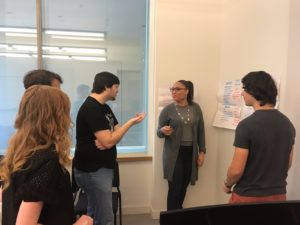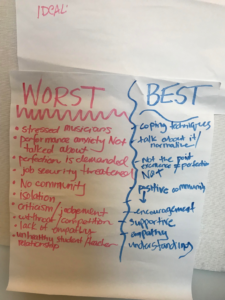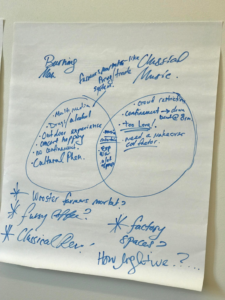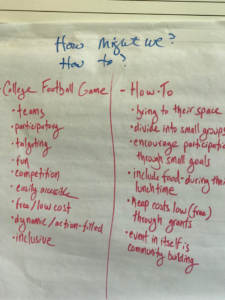 When we last left the students in my Innovation and Collaboration class at the Yale School of Music, they identified the key problems of their audiences. The next order of business was to come up with some creative ideas for solving these problems. We entered the phase of creative problem solving known as “ideation” where students have brainstormed using a variety of techniques. We also have allowed time for the ideas to evolve and improve, thanks to a process known as incubation. We learned that ideation and incubation are essential elements of innovation.
When we last left the students in my Innovation and Collaboration class at the Yale School of Music, they identified the key problems of their audiences. The next order of business was to come up with some creative ideas for solving these problems. We entered the phase of creative problem solving known as “ideation” where students have brainstormed using a variety of techniques. We also have allowed time for the ideas to evolve and improve, thanks to a process known as incubation. We learned that ideation and incubation are essential elements of innovation.
So let’s see how ideation and incubation helped to generate potential solutions to our audience’s problems.
What’s Problems Are We Solving?
The four project groups in my class have come up with the following problem statements:
Musicians and Stress:
Musicians need ways to cope with the stress and anxiety that they experience during and surrounding performance so that they can lead healthy lives and spread the joy of music freely.
Lack of Diversity in Classical Music:
Children in the New Haven public schools from diverse communities and their families need exposure to live music from diverse role models to empower them to share their voices and feel included in society.
Informal Concerts for Yale non-Music Students:
Non-music college and graduate students at Yale need accessible and engaging community-building musical events to relieve stress, create more community and reflect upon their lives.
Empathy and Creativity Workshop for Yale non-music Graduate Students:
Non-music graduate and professional students at Yale need community, self-esteem and a broader perspective because of a human need for collaborative learning, creativity, and empathy in their lives and respective fields of work.
Have Fun with Ideation!
Now it was time to explore new ways of solving the needs of each audience. This is a step known as Ideation.
Ideation is what many people associate with creativity: generating a lot of new, wild, crazy ideas.
The goal of Ideation is to generate as many ideas as possible that could potentially solve the problem at hand. Then, you select the most promising tentative solution to the challenge. Ideation is often a messy, fun, unpredictable process that takes many twists and turns. It’s hard to capture the spirit of the process on paper but there are many interesting lessons that I would like to share with you.
There are lots of ideation techniques that fall under the rubric of “brainstorming”. In class, we previously brainstormed with brainwriting and group brainstorming.
This time, we used two new kinds of brainstorming:
- Worst of the Worst
The Stress and Diversity groups had a great time with a brainstorming technique called the “Worst of the Worst”.
With this technique, you identify the key characteristics of your problem and brainstorm the WORST possible solution. Then, you flip the worst characteristics to come up with the BEST characteristics. This process often gets the buy-in of skeptics who take a dim view of Ideation as unrealistic and too frivolous.
Our two groups found valuable insights from this process:
Diversity Group:

The group flipped these ideas to come up with a community-based interactive concert with diverse student performers and diverse repertoire in community-based venues.
Stress in Classical Musicians:

The Stress group incorporated these ideas to come up with ways to normalize the conversation around stress and performance anxiety in musicians. They also are proposing to create an effective on-line platform where musicians can safely share about stress or access resources to help manage stress and performance anxiety.
- Analogous Attributes
The two groups targeting non-music Yale students explored the technique of Analogous Attributes. This technique involves looking to an unrelated but analogous situation, identifying its characteristics, examining the value and the drawback of each attribute, selecting the most promising attribute and adapting the attribute to your situation.
Informal Concerts:
The informal concert group chose the analogous situation of Burning Man. Their goal is to provide an informal concert produced by students for students with an interactive, community-building component to help unite the disparate graduate school communities at Yale.

Workshop for Non-Music Yale Graduate Students:
The workshop group used the analogy of a college football game. They aim to provide an educational program for young adults that provokes creative thinking, introspection and awareness through empathy.
 Incubation
Incubation
With each exercise and new process, the ideas for the projects keep building and improving. This is a critical part of creative thinking know as Incubation. Ideation and innovation go hand-in-hand. And incubation can follow any stage of creative problem solving and innovating.
While some people think that creativity happens with a brilliant “Eureka” moment–think Isaac Newton discovering gravity after watching an apple fall from the tree– in reality those “Eureka” moments follow hours, months or sometimes years of preparation. In fact, Newton labored for over 17 years on the problem of gravity before publishing his breakthrough solution. That’s because your brain needs time to process, organize and make connections among your inputs. Thus, incubation involves:
- Working on a problem and laying the groundwork for a solution;
- Leaving the problem when you can’t go any further; and
- Returning to the problem to incorporate new ideas and make new connections among your ideas.
In fact, incubation requires preparation so that that the elements of a great ideas are in place for you.
Bottom Line:
Generating creative solutions is complicated! Ideation and incubation are ideal processes that have helped push our projects to the next level. And using the processes of creative thinking can help to organize an otherwise messy process.
Next time: getting feedback to improve creative solutions.

